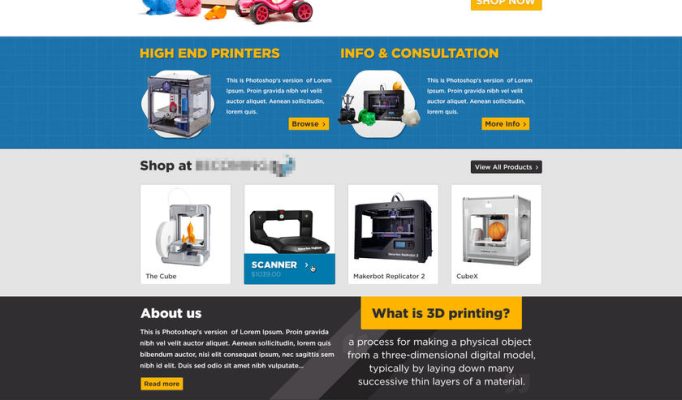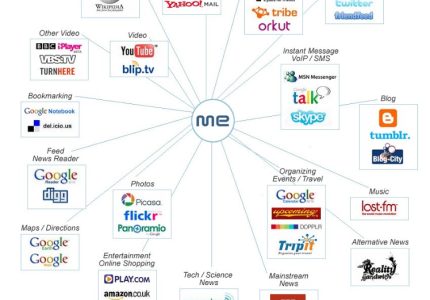Importance of Effective Company Website Design
An effective company website design is essential for establishing a strong online presence and attracting potential customers. A well-designed website not only enhances user experience but also builds credibility and trust with visitors. In today’s digital age, a professional and user-friendly website serves as a crucial gateway for business growth and competitive advantage.
Building Brand Credibility
An effectively designed company website is crucial for establishing a strong online presence and building brand credibility. It serves as the digital storefront that shapes first impressions and influences how customers perceive the brand.
Having an intuitive and visually appealing website can enhance user engagement, making visitors more likely to trust the company and consider its products or services. A professional design demonstrates expertise, reliability, and attention to detail, all of which contribute to overall brand credibility.
- Clear and consistent branding helps reinforce brand identity and makes the company memorable.
- Responsive design ensures accessibility across various devices, improving user experience and trust.
- Easy navigation allows visitors to find information effortlessly, increasing conversion chances.
- High-quality content and visuals reflect professionalism and commitment to quality.
- Fast loading speeds improve user satisfaction and reduce bounce rates, bolstering credibility.
User Experience and Engagement
Effective company website design is crucial in establishing a strong online presence and attracting potential customers. A well-designed website not only reflects the brand’s identity but also builds credibility and trust among visitors.
Focusing on user experience ensures that visitors can easily navigate the site, find relevant information quickly, and engage with the content seamlessly. An intuitive layout, fast loading times, and mobile responsiveness contribute significantly to a positive user experience.
Engagement is enhanced through strategic visual elements, compelling content, and interactive features that encourage visitors to stay longer and take desired actions. A website that prioritizes user engagement fosters relationships, increases conversions, and ultimately drives business growth.
SEO and Discoverability
An effective company website design, combined with strong SEO practices and enhanced discoverability, is crucial for establishing a successful online presence. A well-designed website not only attracts visitors but also encourages them to engage and convert into customers. Ensuring the site is visually appealing, user-friendly, and aligned with brand identity builds trust and credibility.
SEO and discoverability amplify the reach of the website, making it easier for potential clients to find your business through search engines. Proper optimization ensures that your website ranks higher in search results, increasing visibility and driving organic traffic. When your website is optimized for relevant keywords and structured effectively, it becomes more accessible to users seeking your products or services.
- Enhanced User Experience: Clear navigation, fast loading times, and responsive design improve visitor engagement and retention.
- Increased Traffic and Leads: Optimized SEO strategies attract targeted audiences searching for related keywords.
- Brand Credibility and Trust: Visually appealing and professional design fosters confidence in your company.
- Competitive Advantage: A well-structured website with strong SEO differentiates your business from competitors.
- Cost-Effective Marketing: Organic discoverability reduces dependence on paid advertising and offers long-term benefits.
Investing in effective website design, SEO, and discoverability ultimately translates into higher conversions, increased revenue, and sustained business growth.
Key Elements of Company Website Design
Creating an effective company website requires careful attention to key design elements that engage visitors and convey professionalism. A well-designed website not only enhances brand credibility but also improves user experience through intuitive navigation, appealing visuals, and clear calls to action. Understanding these essential components can help businesses build an online presence that attracts and retains customers effectively.
Responsive Layouts
Effective company website design incorporates key elements that ensure a professional, user-friendly, and visually appealing online presence. Responsive layouts are vital, allowing the website to adapt seamlessly across various devices, including desktops, tablets, and smartphones. This flexibility enhances user experience by providing consistent functionality and appearance regardless of screen size. Clear navigation menus help visitors find information easily, while visually engaging graphics and balanced use of colors create an attractive aesthetic. Additionally, fast loading times, accessible content, and engaging calls-to-action contribute to higher user engagement and conversion rates. Overall, integrating these elements results in a website that not only represents the brand effectively but also encourages visitors to interact and engage with the company’s offerings.
Clear Navigation
Clear navigation is a fundamental element of effective company website design, ensuring visitors can easily find the information they seek. It involves organizing menu items logically and intuitively, often utilizing a simple and consistent layout across all pages. Clear labels and a straightforward menu structure help users understand where they are and where they can go next, reducing frustration and increasing engagement.
Visual Hierarchy
Effective company website design focuses on creating a user-friendly experience that effectively communicates the brand’s message and encourages engagement. One essential aspect is establishing a clear visual hierarchy, guiding visitors through the content seamlessly and highlighting the most important information.
- Clear Navigation Structure: Organizing menu items and links intuitively to help users find information quickly.
- Consistent Branding: Using cohesive colors, fonts, and imagery that reflect the company’s identity.
- Readable Typography: Choosing legible fonts and appropriate sizes to enhance readability and convey professionalism.
- Strategic Use of Colors: Employing color schemes that draw attention to key areas and evoke the desired emotional response.
- Effective Use of White Space: Allowing space around elements to reduce clutter and focus attention on important content.
- Visual Focus Points: Utilizing size, contrast, and placement to emphasize critical sections such as calls-to-action or product features.
- Responsive Design: Ensuring the website adapts seamlessly to different devices and screen sizes for optimal user experience.
Consistent Branding
Effective company website design is crucial for establishing a strong online presence and ensuring a positive user experience. It involves various key elements that work together to create an engaging and functional site. Consistent branding is one of the most important aspects, as it reinforces brand identity and builds trust with visitors.
- Clear and intuitive navigation to help visitors find information easily.
- Responsive design that adapts seamlessly to different devices and screen sizes.
- Visual hierarchy to highlight important content and guide user attention.
- Engaging visuals and multimedia elements to attract and retain visitors.
- Fast loading times to enhance user experience and reduce bounce rates.
- Effective call-to-action (CTA) buttons to drive desired user actions.
- Search engine optimization (SEO) fundamentals to improve visibility.
- Consistent branding through the use of logo, color schemes, typography, and messaging across all pages.
- Trust signals like testimonials, case studies, and security badges to increase credibility.
- Accessible design to ensure usability for all visitors, including those with disabilities.
Maintaining consistent branding across a website helps build recognition, conveys professionalism, and establishes a memorable identity that resonates with the target audience.
Design Principles for Company Websites
Effective company website design is essential for establishing a strong online presence and engaging visitors. By applying key design principles, businesses can create user-friendly, visually appealing, and professional websites that accurately represent their brand and support their goals. Thoughtful design choices enhance user experience, build trust, and drive conversions, making it a crucial aspect of modern digital marketing strategies.
Simplicity and Clarity
Simplicity and clarity are fundamental principles in designing effective company websites. A clean and straightforward layout helps visitors easily find the information they need without feeling overwhelmed. Clear navigation menus guide users intuitively through the site, enhancing their overall experience. Utilizing simple language and visual elements ensures that the message is accessible and easily understood. By minimizing clutter and focusing on essential content, companies can create a professional image that communicates their value clearly and efficiently to their audience.
Visual Appeal
Creating a visually appealing company website is essential for establishing a strong online presence and engaging visitors effectively. A well-designed site should prioritize clean and consistent layouts that reflect the brand’s identity and values.
Utilizing a harmonious color scheme enhances visual interest and reinforces brand recognition. It’s important to balance colors to ensure readability and avoid overwhelming users.
Effective use of typography plays a crucial role in readability and aesthetic appeal. Choose fonts that are legible and complement the overall design, while also establishing a clear hierarchy to guide visitors through content easily.
Incorporating high-quality images and graphics adds visual interest and conveys professionalism. Visual elements should support the content, align with brand messaging, and be optimized for fast loading times.
Whitespace, or negative space, should be thoughtfully integrated to prevent clutter and improve focus on key elements. It creates a sense of openness and helps guide users naturally through the website.
Finally, a consistent style across all pages and components ensures a cohesive look, building trust and familiarity with visitors. The overall visual appeal of a website directly influences user experience and can significantly impact the company’s credibility and success.
Accessibility
Effective company website design is centered around creating an engaging and user-friendly experience that aligns with the company’s goals. Key principles include simplicity, ensuring that navigation is intuitive and content is easy to find. Visual hierarchy should guide visitors naturally through the site, highlighting the most important information. Consistency in design elements such as colors, fonts, and layout helps build brand recognition and trust. Additionally, responsive design ensures that the website functions well across all devices, providing a seamless experience.
Accessibility is a crucial aspect of website design that ensures all users, including those with disabilities, can access and interact with the site effectively. This involves using clear and descriptive text for images and links, enabling screen readers to interpret content properly. Proper contrast between text and background improves readability for users with visual impairments. Keyboard navigation should be smooth, allowing users to move through the site without reliance on a mouse. Furthermore, avoiding multimedia that auto-plays or is difficult to control enhances accessibility for users with sensory sensitivities. Incorporating accessibility considerations from the outset broadens reach and demonstrates inclusivity, ultimately benefiting both users and the company’s reputation.
Performance Optimization
Design principles for company websites focused on performance optimization aim to create fast, efficient, and user-friendly digital experiences that accurately represent the brand while ensuring quick load times and smooth interactions. Prioritizing these principles enhances user satisfaction and boosts conversions.
- Minimize page load times by optimizing images, leveraging browser caching, and reducing the use of heavy scripts.
- Ensure a responsive design that adapts seamlessly across devices and screen sizes, providing consistent performance everywhere.
- Use clean and organized code structure to enhance rendering speed and maintainability.
- Implement lazy loading for images and resources to improve initial load performance.
- Optimize server response times through reliable hosting solutions and efficient backend processes.
- Reduce the number of HTTP requests by combining files, such as CSS and JavaScript, and removing unnecessary plugins.
- Prioritize mobile-first design to cater to the growing mobile user base and improve overall site performance.
- Utilize Content Delivery Networks to distribute content efficiently and decrease latency for global users.
- Regularly test website performance using tools like Google PageSpeed Insights or GTmetrix to identify and address issues.
- Maintain a simple, intuitive user interface that allows users to find information quickly without unnecessary clutter.
Choosing the Right Technology Stack
Choosing the right technology stack is a crucial step in designing an effective and scalable company website. It determines the website’s performance, security, and ability to adapt to future needs. By selecting appropriate frameworks, programming languages, and tools, businesses can ensure a seamless user experience and efficient development process that aligns with their goals.
Content Management Systems (CMS)
Choosing the right Content Management System (CMS) is a crucial step in designing an effective company website. A suitable CMS should align with your business needs, technical expertise, and long-term goals, ensuring ease of use, scalability, and flexibility. Consider factors such as customization options, available plugins or extensions, and the level of security provided by the platform. Popular CMS options like WordPress, Joomla, or Drupal each offer unique features tailored to different types of organizations, from small businesses to large enterprises. Evaluating these options based on your specific requirements will help create a responsive, user-friendly, and easily maintainable company website that supports your digital marketing and branding strategies.
Front-end Frameworks
Selecting the appropriate front-end framework is a crucial step in designing a company website, as it directly impacts the website’s performance, user experience, and scalability. A well-chosen framework can streamline development, improve maintainability, and ensure the site is responsive across various devices. When evaluating options, consider factors such as ease of use, community support, integration capabilities, and the specific needs of the business. Popular front-end frameworks like React, Vue.js, and Angular each offer unique advantages; React is known for its flexibility and large ecosystem, Vue.js provides simplicity and gentle learning curves, while Angular offers a comprehensive solution with built-in features. Aligning the framework choice with the company’s technical expertise and project requirements will lead to a more effective and long-lasting website design.
Hosting and Security
Selecting the appropriate technology stack, hosting solution, and security measures is crucial for creating a reliable and scalable company website. These choices impact the website’s performance, maintainability, and security, ultimately influencing user experience and business success.
- Identify your website’s primary functions and requirements, such as e-commerce, content management, or customer interaction, to determine suitable technologies.
- Choose a technology stack that aligns with your team’s expertise and future scalability, including frameworks, programming languages, and databases.
- Opt for a hosting provider that offers reliable uptime, adequate bandwidth, and geographic server locations to ensure optimal performance.
- Implement security best practices, including SSL certificates, regular software updates, firewalls, and data encryption to protect sensitive information.
- Consider scalability options like cloud hosting services that can grow with your business demand and traffic fluctuations.
- Regularly monitor and audit your security protocols to identify vulnerabilities and ensure compliance with relevant data protection regulations.
- Balance cost, performance, and security features when choosing between options such as shared hosting, virtual private servers, or dedicated servers.
Best Practices for Company Website Development
Creating an effective company website requires adhering to best practices in design and development to ensure user engagement and optimal performance. A well-designed website not only reflects the brand’s identity but also provides a seamless experience for visitors, encouraging them to explore and take desired actions. Focusing on clarity, usability, and responsive design are essential components of successful website development in today’s digital landscape.
User-Centered Design
Creating an effective company website requires a focus on user-centered design to ensure visitors have a positive experience and easily find the information they need. Implementing best practices in website development can significantly enhance usability, accessibility, and overall engagement.
- Conduct User Research: Understand your target audience’s preferences, behaviors, and needs through surveys, interviews, or analytics. This helps tailor the website to meet their expectations.
- Prioritize Simplicity and Clarity: Design a clean and intuitive layout that highlights essential information, making navigation straightforward and reducing cognitive load.
- Ensure Mobile Responsiveness: Optimize the website for all devices, including smartphones and tablets, to provide a seamless experience regardless of screen size.
- Use Consistent Branding: Incorporate your company’s branding elements such as logo, colors, and typography consistently across all pages to build identity and trust.
- Focus on Accessibility: Design with accessibility in mind by using proper contrast, readable fonts, and alternative text for images, making the website usable for all visitors.
- Implement Clear Calls to Action: Guide users towards desired actions with prominent buttons and links, such as contact forms, services, or product pages.
- Improve Loading Speed: Optimize images, code, and server performance to reduce load times, enhancing user satisfaction and SEO rankings.
- Utilize User Feedback: Regularly seek feedback from visitors and analyze user behavior to identify pain points and continuously improve the website experience.
- Maintain Content Relevance and Freshness: Keep website content updated and relevant to encourage repeat visits and establish authority in your industry.
Regular Testing and Updates
Developing a company website involves implementing best practices to ensure a professional, user-friendly, and secure online presence. A well-designed website should prioritize clear navigation, responsive design for various devices, and fast load times to enhance user experience. It’s essential to create a visual identity that aligns with the brand and communicates key messages effectively.
Regular testing and updates are crucial to maintain the website’s functionality, security, and relevance. Conduct periodic testing across different browsers and devices to identify and resolve compatibility issues. Implement security measures such as SSL certificates and regular backups to protect sensitive data. Keep website content fresh and relevant by updating information, images, and features routinely to meet changing customer needs and industry standards.
Analytics and Feedback Integration
Developing an effective company website involves implementing best practices that enhance user experience, functionality, and credibility. A clean, intuitive design ensures visitors can easily navigate and find information, leading to higher engagement and conversion rates.
Optimizing website performance by ensuring fast load times and mobile responsiveness is crucial, as it directly impacts user satisfaction and search engine rankings. Incorporating clear calls to action guides visitors toward desired goals, such as making inquiries or purchasing products.
Integrating analytics tools like Google Analytics provides valuable insights into visitor behavior, traffic sources, and conversion metrics. Regularly monitoring this data helps identify areas for improvement and assess the effectiveness of marketing strategies.
Feedback mechanisms, such as surveys, live chat, or comment sections, enable companies to gather direct input from users. Analyzing this feedback helps identify pain points, understand customer needs, and tailor offerings to improve overall service quality.
Ensuring the website adheres to accessibility standards makes it usable for all visitors, including those with disabilities. Consistent updates, security measures, and content quality further establish trust and authority in the industry.
Future Trends in Company Website Design
As technology continues to evolve rapidly, company website design is transforming to meet the changing expectations of users and the competitive digital landscape. Innovative trends are emerging that emphasize enhanced user experience, responsiveness, and visual engagement, shaping the future of how businesses present themselves online. Staying ahead of these trends is essential for companies aiming to attract and retain visitors in an increasingly digital world.
AI and Personalization
Future trends in company website design are increasingly focused on integrating advanced artificial intelligence and personalized experiences to better serve visitors. As AI technology continues to evolve, websites are becoming more intelligent, capable of providing tailored content, recommendations, and support in real-time. Personalization is shifting from basic customization to sophisticated algorithms that adapt website interfaces based on user behavior, preferences, and demographics, creating more engaging and relevant interactions. Additionally, adaptive design, which adjusts layout and functionality for various devices and user contexts, is gaining prominence. Enhanced visual aesthetics, such as immersive visuals and dynamic elements, combined with seamless navigation and accessibility, will further improve user experience. Overall, the future of website design will prioritize intelligent, personalized interactions that foster stronger connections between companies and their audiences, driving engagement and conversions.
Voice Search Optimization
Future trends in company website design are continuously evolving, driven by technological advancements and changing user preferences. One significant area of focus is voice search optimization, which is becoming increasingly important as voice-activated devices gain popularity. Designing websites that are voice-friendly enhances accessibility and improves user experience, ensuring that content is easily discoverable through voice commands.
- Semantic HTML and natural language processing will be integrated to better understand voice queries.
- Optimizing content for voice search through the use of featured snippets and concise, conversational answers.
- Implementing structured data markup to help search engines, including voice assistants, better interpret website content.
- Designing more intuitive and minimalist interfaces that facilitate easier navigation via voice commands.
- Enhancing mobile responsiveness, as voice search usage is predominantly on mobile devices.
- Prioritizing fast-loading pages to meet the quick response expectations of voice search users.
- Using AI-powered chatbots and virtual assistants to provide seamless interaction and support.
Overall, future website designs will focus on creating more interactive, accessible, and voice-friendly platforms that cater to the increasing adoption of voice technology in everyday browsing.
Video and Interactive Content
Future trends in company website design are increasingly focused on delivering engaging, personalized, and immersive experiences for users. As technology advances, websites are likely to incorporate more dynamic visuals, seamless animations, and intuitive interfaces to enhance user engagement. Interactive content such as quizzes, virtual tours, and clickable infographics will become more prevalent, allowing visitors to explore offerings in a more meaningful way.
Video content will continue to dominate, with short-form videos, live streaming, and 360-degree videos becoming standard features to showcase products and company stories. Incorporating high-quality videos directly into webpage layouts will improve storytelling and increase user retention. Additionally, websites will leverage AI-powered personalization to deliver tailored video content based on user preferences and behavior.
Interactive elements like augmented reality, virtual reality, and interactive videos will revolutionize how companies communicate their brand. These features enable visitors to virtually try products, participate in immersive brand experiences, or access interactive demos, creating memorable and engaging journeys. Overall, future company websites will prioritize user-centric, immersive, and personalized content to stand out in a competitive digital landscape.





